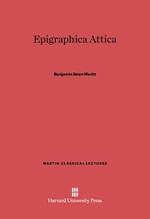
Epigraphica attica PDF
Preview Epigraphica attica
MARTIN CLASSICAL LECTURES 2. I. The Martin Classical Lectures 3.Edited byLouis E. Lord 4A.spects of Social Behavior in Ancient Rome TenneyFrank 5. Attic Vase-.Painting 6. CharlesT. Seltman The Humanistic Value ofArchaeology 7. Rhys Carpenter 8. Greek Ideals and Modern Life SirRichardW. Livingstone 9. Five Men: Character Studies from the Roman Empire MartinPercival Charlesworth Early Greek Elegists CecilM. Bowra The Roman Art ofWar Under the Republic F. E.Adcock Epigraphica Attica BenjaminDeanMeritt MARTIN CLASSICAL LECTURES These lectures are delivered annually at OBERLIN COLLEGE on a Foundation established in honor of CHARLES BEEBE MARTIN LONDON HUMPHREY MILFORD : OXFORD UNIVERSITY PRESS EPIGRAPHICA ATTICA MARTIN CLASSICAL LECTURES VOLUME IX BY BENJAMIN DEAN MERITT Institute forAdvanced Study, Princeton, New Jersey CD A Deft ' ? P'"": CAMBRIDGE MASSACHUSETTS : HARVARD UNIVERSITY PRESS 1940 COPYRIGHT, 1940 BY THE PRESIDENT AND FELLOWS OF HARVARD COLLEGE ' 'iiiAl’Y 1 It• { ••rW'SaolWlfcS i' *. PRINTED AT THE HARVARD UNIVERSITY PRESS CAMBRIDGE, MASS., U.S.A. THE MARTIN CLASSICAL LECTURES i Volume IX The Martin Foundation^ on which these lectures are delivered, was established byhis many friends in honor of Charles Beebe Martin, for forty-five years a teacher of classical literature and classical art in Oberlin College PREFACE T hese lectures^ which were delivered in Oberlin upon the Charles Beebe Martin Foundation in November 1939, are here printed in a somewhat modified form. Their substance is the same^ but especiallyin thefieldofepigraphyone’soralpresenta- tion must dispense with the rather cumbersome citations and references which convention seems to require for thejustification ofa written argument. The central theme is very simple. The author has wished to show by example that inscriptions cannot be studied satisfactorily without proper attention to the physical properties of the stones on which they were inscribed. He hopes the reader will not take it amiss that the illustrations are drawn largely from his own experience with the documents of Athens. There is no attempt to cite all the examples that might be used to show the desirability of such com- plete study;, and every epigraphist will doubtless call to mind equallygood examples ofhis own. Themain purposeofthe volumeis to emphasize theimportance to the text ofa knowledge ofits medium. Grateful acknowledgment is made to Mr. W. Kendrick Pritchett for reading the manuscript and to Miss Margot Cutter for her patience and care in my its preparation. It is a pleasure also to record obligation to the skilled staff of the Harvard Uni-
